The 2020 Mac Mini Unleashed: Putting Apple Silicon M1 To The Test
by Andrei Frumusanu on November 17, 2020 9:00 AM ESTBenchmarks: Whatever Is Available
As we’ve had very little time with the Mac mini, and the fact that this not only is a macOS system, but a new Arm64-based macOS system, our usual benchmark choices that we tend to use aren’t really available to us. We’ve made due with a assortment of available tests at the time of the launch to give us a rough idea of the performance:

One particular benchmark that sees the first light of day on macOS as well as Apple Silicon is Cinebench. In this first-time view of the popular Cinema4D based benchmark, we see the Apple M1 toe-to-toe with the best-performing x86 CPUs on the market, vastly outperforming past Apple iterations of Intel silicon. The M1 here loses out to Zen3 and Tiger Lake CPUs, which still seem to have an advantage, although we’re not sure of the microarchitectural characteristics of the new benchmark.
What’s notable is the performance of the Rosetta2 run of the benchmark when in x86 mode, which is not only able to keep up with past Mac iterations but still also beat them.
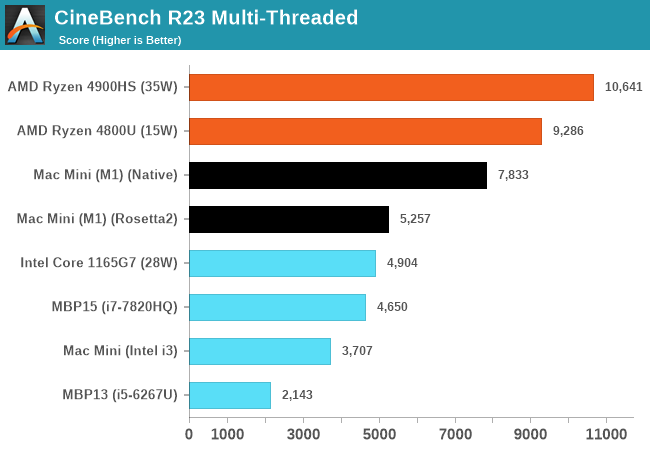
In the multi-threaded R23 runs, the M1 absolutely dominates past Macs with similar low-power CPUs. Just as of note, we’re trying to gather more data on other systems as we have access to them, and expand the graph in further updates of the article past publishing.
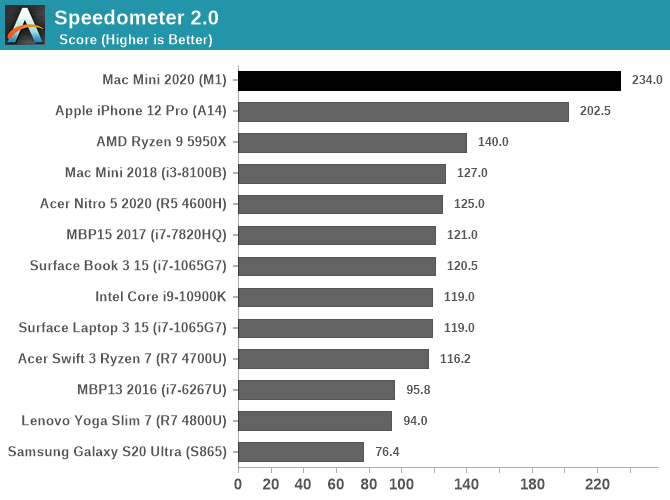
In browser-benchmarks we’ve known Apple’s CPUs to very much dominate across the landscape, but there were doubts as to whether this was due to the CPUs themselves in the iPhone or rather just the browsers and browser engines. Now running on macOS and desktop Safari, being able to compare data to other Intel Mac systems, we can come to the conclusion that the performance advantage is due to Apple’s CPU designs.
Web-browsing performance seems to be an extremely high priority for Apple’s CPU, and this makes sense as it’s the killer workload for mobile SoCs and the workload that one uses the most in everyday life.
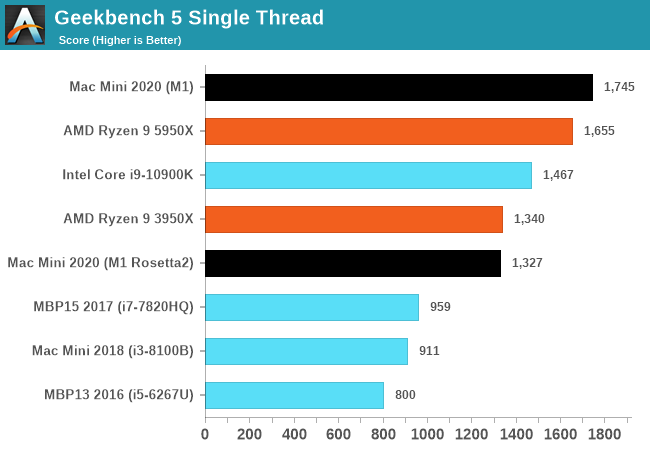
In Geekbench 5, the M1 does again extremely well as it actually takes the lead in our performance figures. Even when running in x86 compatibility mode, the M1 is able to match the top single-threaded performance of last generation’s high-end CPUs, and vastly exceed that of past iterations of the Mac mini and past Macbooks.
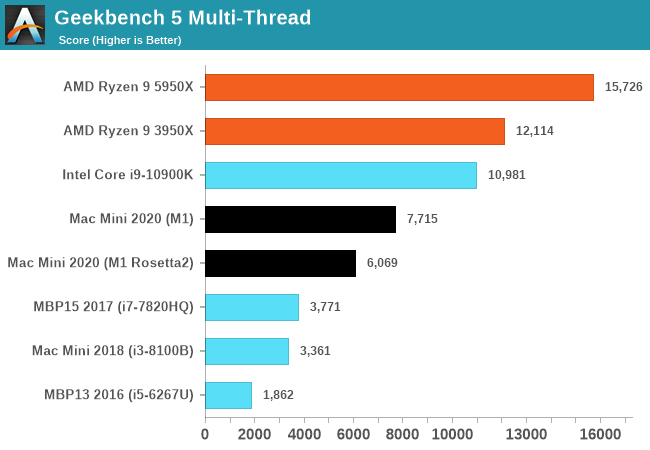
Multi-threaded performance is a matter of core-count and power efficiency of a design. The M1 here demolishes a 2017 15-inch Macbook Pro with an Intel i7-7820HQ with 4 cores and 8 threads, posting over double the score. We’ll be adding more data-points as we collect them.


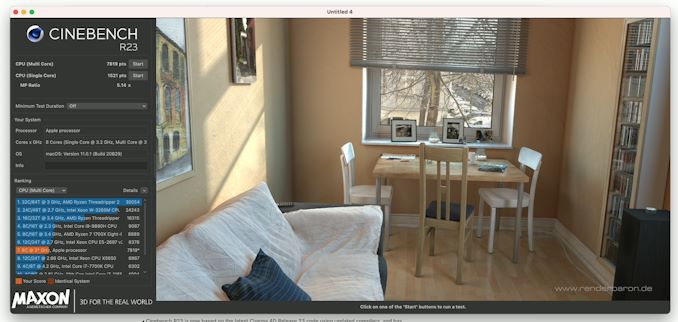








682 Comments
View All Comments
Eric S - Tuesday, November 17, 2020 - link
That cash is the reason Apple is getting so much of the 5 nm node production.varase - Wednesday, November 25, 2020 - link
You can pretty much forget Microsoft - there is no compelling ARM Microsoft software, and if ARM Windows does do x86 transcompiling it will almost certain be to the standard ARM instruction set, or worse to a Microsoft/Qualcomm mutated instruction set. In no case would it be the Apple SIlicon's AArch64 implantation.If they relied on interpretation instead of trans compilation, expect performance to be less than stellar.
Now Parallels seems to be working on something that they're keeping pretty mum about - my guess would be a hypervisor running x64 clients. Using Rosetta 2 like trans compilation, they could front end OS boot and segment loaders and read x64 code segments and return Apple Silicon AArch64 code to the client virtual machine. They'd probably have to front end code signing segments if those exist. To sustain performance, they'd also have to cache transcompiled code using a source/CRC/length key to prevent having to transcompile all the code all the time.
They wouldn't have Metal access to GPUs to lean back on, so unless Apple implements PCIe attached graphic cards I wouldn't expect gaming to ever be performant enough to be practical.
hlovatt - Tuesday, November 17, 2020 - link
Isn't the 22 W you quote for Apple for the whole system, whereas the 25 W you quote for AMD is just the processor? In't a 10 W Apple processor competitive with a 25 W AMD processor?halo37253 - Wednesday, November 18, 2020 - link
No thats full system power from the wall of AMD's 4800u in 15watt mode.whatthe123 - Tuesday, November 17, 2020 - link
By anandtech's standards these benchmarks are highly misleading, though. 5950x is capped off to its lowest possible package power. In MT testing they switch back to zen 2 chips also power limited. Everything is focusing on efficiency, which is admittedly very, very good, but the article frames it as though these are stock comparisons, when in reality most of these CPUs would be able to draw more power and dwarf the M1 in performance.If they are only looking at efficiency, why make such a misleading article? Just focus on efficiency and the results are stellar. Instead they went with this mess of an article, I'm honestly shocked considering this site normally tries to be unbiased as possible.
Spunjji - Thursday, November 19, 2020 - link
@whatthe123 - "5950x is capped off to its lowest possible package power" - where did you get that impression from?Spunjji - Thursday, November 19, 2020 - link
@whatthe123 - Regarding your complaint that they only compare the 5950X to the M1 in ST testing, of course they do, it's a 16-core 32-thread chip with a 105W TDP and ~140W power limit. It'll demolish the ~24W 4+4 M1 in MT. That's just... not a useful comparison.The point is to show AMD's peak Zen 3 performance against Apple's peak Firestorm performance. Once AMD have Zen 3 processors in the ~25W range, then a valid MT comparison in comparable designs can be made.
helpmeoutnow - Thursday, November 26, 2020 - link
@Spunjji but be fair we want to see the difference between this M1 and fully utilized 5950X just to see the real difference. Now it looks like m1 is a good cpu. but as it is said, they just cap everything else.Stephen_L - Tuesday, November 17, 2020 - link
Nah, no just listen to op, we HAVE to compare chips on the same node! Let’s wait for Intel 7nm also, hopefully in 2022 but god knows if they can do it before 2024, so we can have “Apples to apples comparison”. Let’s come back in 2-4 years guys. /smagreen - Tuesday, November 24, 2020 - link
Totally agree. The Cyrix M3 Jalapeno when it comes out on 5nm is going to crush this little M1.